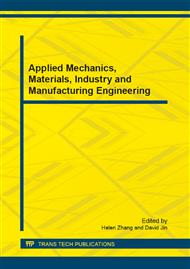[1]
N. Lu, S.G. Zhou, L. Zhuang, J.T. Zhnag, J.R. Ni, Electricity generation from starch processing wastewater using microbial fuel cell technology, Biochem. Eng. J. 43 (2009) 246–251.
DOI: 10.1016/j.bej.2008.10.005
Google Scholar
[2]
Z. He, S.D. Minteer, L.T. Angenent, Electricity generation from artificial wastewater using an upflow microbial fuel cell, Environ. Sci. Technol. 39 (2005) 5262–5267.
DOI: 10.1021/es0502876
Google Scholar
[3]
T. Zhang, Y.L. Zeng, S.L. Chen, Improved performances of E. coli-catalyzed microbial fuel cells with composite graphite/PTFE anodes, Electrochemistry Communications. 9 (2007) 349-353.
DOI: 10.1016/j.elecom.2006.09.025
Google Scholar
[4]
D.Y. Fan, Y.H. Chen, Probability theory and mathematical statistics, Zhejiang University Press, Zhejiang China, 1996, p.215.
Google Scholar
[5]
W.E. Balch, G.E. Fox, L.J. Magrum, C.R. Woese, R.S. Wolfe, Methanogens: Reevaluation of a unique biological group, Microbiology and Molecular Biology Reviews. 43 (1979) 260-296.
DOI: 10.1128/mr.43.2.260-296.1979
Google Scholar
[6]
H. Liu, B.E. Logan, Electricity generation using an air-cathode single chamber microbial fuel cell in the presence and absence of a proton exchange membrane, Environ. Sci. Technol. 38 (2004) 4040-4046.
DOI: 10.1021/es0499344
Google Scholar
[7]
K. Shinogi, H. Ikeda, T. Ito, T. Watanabe, Effect of preparation for anodic biofilm by electrolytic stimulation on performance of microbial fuel cell, Japan Society on Water Environment. 43 (2009) 165, Japanese.
Google Scholar
[8]
Y. Ahn, B.E. Logan, Effectiveness of domestic wastewater treatment using microbial fuel cells at ambient and mesophilic temperatures, Bioresource Technology. 101 (2010) 469–475.
DOI: 10.1016/j.biortech.2009.07.039
Google Scholar
[9]
K. Rabaey, G. Lissens, S. Siciliano, W. Verstraete, A microbial fuel cell capable of converting glucose to electricity at high rate and efficiency, Biotechnol. Lett. 25 (2003) 1531–1535.
DOI: 10.1023/a:1025484009367
Google Scholar
[10]
B.E. Logan, D. Call, S. Cheng, H.V.M. Hamelers, T.H.J.A. Sleutels, A. Jeremiasse, R.A. Rozendal, Microbial electrolysis cells for high yield hydrogen gas production from organic matter, Environ. Sci. Technol. 42 (2008) 8630–8640.
DOI: 10.1021/es801553z
Google Scholar
[11]
J.R. Kim, S. Cheng, S. Oh, B.E. Logan, Power generation using different cation, anion, and ultrafiltration membranes in microbial fuel cells, Environ. Sci. Technol. 41 (2007) 1004-1009.
DOI: 10.1021/es062202m
Google Scholar
[12]
R.Y. Hamid, S.M. Carverb, A.D. Christya, O.H. Tuovinenb, Cathodic limitations in microbial fuel cells: An overview, Journal of Power Sources. 180 (2008) 683-694.
Google Scholar


